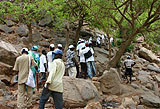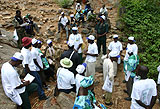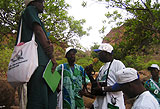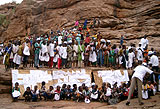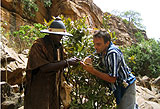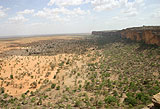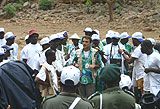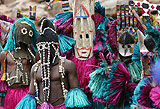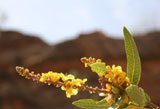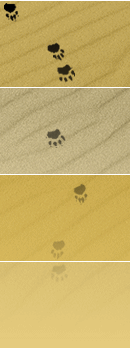| |
|
The cliff of Bandiagara – Oasis of biological diversity in the Land of the Dogons
Excursion studies biological diversity and promotes dialogue between modern science and traditional knowledge
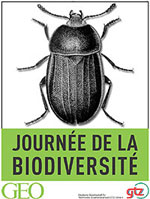 04th June 2005 after daybreak: In the village Enndé at the foot of the impressive cliff more than 100 scientists, politicians, environmentalists, journalists as well as Dogon healers, hunters and farmers start for a remarkable excursion. They gather to study the biodiversity and the ecological quality of the cliff of Bandiagara (Falaise de Bandiagara) and the neighbouring Dogon plateau in the framework of the GEO Day of Biological Diversity.
04th June 2005 after daybreak: In the village Enndé at the foot of the impressive cliff more than 100 scientists, politicians, environmentalists, journalists as well as Dogon healers, hunters and farmers start for a remarkable excursion. They gather to study the biodiversity and the ecological quality of the cliff of Bandiagara (Falaise de Bandiagara) and the neighbouring Dogon plateau in the framework of the GEO Day of Biological Diversity.
The location of this first GEO Day of Biological Diversity in Africa is a unique place in the entire Sahel. The escarpment of the Falaise de Bandiagara with its villages nestled in the cliff possesses a extraordinary fauna and flora. Thanks to the water reservoir of the Dogon plateau, plants and animals can be found along the escarpment that usually only exist in more humid zones in the south of West Africa. Unlike the rich cultural heritage of the land of the Dogons and the unique landscape of the Falaise, which were declared world cultural and natural heritage by the UNESCO in 1989, only very little is known about the “oasis of biodiversity” along the escarpment and on the plateau.
Some 100 participants of this year’s GEO Day of Biological Diversity follow a particular approach: Scientists and experts with traditional knowledge study typical plants and animals on different sites and discuss their findings with the other participants. Thus a dialogue between modern science and traditional knowledge is established: Researchers healers, farmers and hunters exchange their knowledge on biodiversity, endangered species and the use of different plants in traditional medicine. One bush is of particular interest to the specialists: Acridocarpus monodii is a plant that exists exclusively in a perimeter of 100 km in the Land of the Dogons. Only few is known about this endemic species, the Dogon call it "Sagontara pampagna" and use it as an efficient remedy for malaria.
The exchange of ideas and experiences goes beyond the status quo of biodiversity and its use for herbal medicine. Local representatives, scientists and representatives of environment-related administration and NGOs discuss possible concepts and measures for the conservation and sustainable use of biodiversity in the Land of the Dogons.
About 1.000 inhabitants of the neighbouring villages participate in the side-events of the GEO Day of Biological Diversity. Thus the event raises the awareness of the local communities on biodiversity, its conservation and sustainable use. A representative of German Agro Action reports about the importance of agrobiodiversity to assure food security and demonstrates different species of millet used in the Land of the Dogons. A local women’s association explains the use of improved hearths in different Dogon villages that reduce the consumption of firewood by 60%. School children from the village of Begnimatu present their paintings on nature and environment-relates issues. The excursion’s cultural highlight is a traditional mask dance in Begnimatu.
A final working session in the village Enndé in the evening compiles and analyses the results of the excursion from both the perspective of modern science as well as traditional knowledge. Possibilities for future measures for the conservation of endangered species and natural resources are identified and discussed. International, national and local experts agree that strengthening the awareness on the uniqueness of the escarpment’s flora and fauna will allow to conserve this extraordinary “oasis of biodiversity”. The Geo Day of Biodiversity is a first step in this direction. Moreover the participation of United Nations Development Programme (UNDP), the German Development Service (DED), German Acro Action, USAID, the French Development Cooperation and GEF Small Grants Programme is an important contribution in terms of national and international donor coordination for future environment-related activities in Mali.
